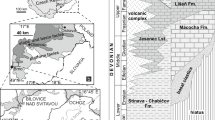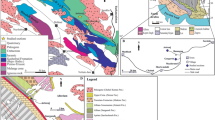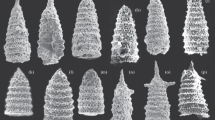Summary
In the top section of the Upper Jurassic profile in the S part of the Cracow-Wielun upland there occur deposits with numerous fragments of the plantonic crinoidsSaccocoma. Sedimentary structures indicate that these deposits are calciturbidites with domination of the redeposited pelagic material. TheSaccocoma-calciturbidites rest on the slope beds of Oxfordian cyanobacterial-sponge carbonate buildups formed in the Polish epicontinental basin, bordering the Tethys ocean in the north. The occurrence of the planktonicSaccocoma seems to be connected with a short deepening the S part of the Polish epicontinental basin in the Late Jurassic. This deepening caused the change within biocoenoses thriving in carbonate buildups and was mainly expressed in reducingTubiphytes. ‘Tubiphytes-reefs’, representing the last stage in the development of the carbonate buildups in the S part of the Cracow-Wielun upland, marked the most shallow sedimentation environment. With deepending of the basin,Tubiphytes and other benthonic forms disappeared, and, simultaneously, the dominant fauna became planktonic. The abundance of planktonic crinoidsSaccocoma (=Lombardia), as well as the presence of planktonic foraminifers, nannoplankton cf.Schizosphaerella, coccoliths and radiolarians indicates a pelagic, open-sea depositional environment.
TheSaccocoma-dominated sediments, which had been primarily deposited from a suspension on a sea floor with a distinct relief, became subsequently transported by turbidity currents. A limited extent and thickness of theSaccocoma-calciturbidites was caused by a relatively small amount of the primary material which could be transferred by the turbidity currents because the period of pelagic sedimentation was short. TheSaccocoma-calciturbidites indicate a distinct shift in conditions of sedimentation resulting from over-regional changes and, despite the lack of index fossils, seem to represent a local lithostratigraphic horizon. These sediments probably mark a sedimentation event which caused a minor levelling of the sea floor relief. Then, after a sedimentation break, wide-spread destruction of the tops of carbonate buildups and formation of debris flows in the shallowing Late Jurassic sea took place.
TheSaccocoma-calciturbidites in the S part of the Cracow-Wielun upland can be found near edges of horsts. This suggests that the foundations of these horsts are probably of sedimentary origin, dating back at least to the Late Jurassic. TheSaccocoma-calciturbidites in the S part of the Polish epicontinental basin seem to result from local, synsedimentary tectonic movements, which probably reflect over-regional events on the one hand, and oscillations of the sea level-on the other.
Similar content being viewed by others
References
Alexandrowicz, S. W. (1960): Geological structure of the vicinity of Tyniec. (Engl. summary).—Biul. IG,152, 5–93, Warszawa.
Bernoulli, D. & Kälin, O. (1984): Jurassic sediments; site 547, Northwest African Margin: remarks on stratigraphy, facies, and diagenesis, and comparison with some Tethyan equivalents. —In:Hinz, K., Winterer, E. L., et al. (eds.): Init. Repts. DSDP,79, 437–448, Washington
Bouma, A. H. (1962): Sedimentology of some flysch deposits. A graphic approach to facies interpretation. 167pp.. Elsevier, Amsterdam
Bromley, R. G. &Frey, R. W. (1974): Redescription of trace fossilGyrolites and taxonomic evaluation ofThalassinoides, Ophiomorpha andSpongeliomorpha.—Bull. Geol. Soc. Denmark,23, 311–335; Copenhagen
Bukowy, S. (1957): New data about the Kimmeridgian in the vicinity of Cracow. (in Polish).—Przeglad Geologiczny,1957/2, 90–91, Warszawa
— (1960): Submarine slides in the rocky limestones near Cracow. (Engl. summary).—Biul. IG,155, 153–168, Warszawa
— (1962): The profile of Jurassic and Creataceous series at Raciborowice near Cracow. (Engl. summary).—Rocznik Pol. Tow. Geol.,32, 197–209, Cracow
Burzewski, W. (1969): Les conditions structurales du Jurassique de la region d’Olkusz et de Wolbrom comme bordieres pour les gisements petroliferes du Bassin de Nida. (French summary). —Prace Geol. PAN,61, 3–91, Warszawa
Bustillo, M. A. &Ruiz-Ortiz, P. A. (1987): Chert occurrences in carbonate turbidites: examples from the Upper Jurassic of the Betic Mountains (southern Spain).—Sedimentology,34, 611–621, Oxford
Crevello, P. D. &Schlager, W. (1980): Carbonate debris sheets and turbidites, Exuma Sound, Bahamas.—J. Sediment. Petrol.,50, 1121–1148, Tulsa
Dzulynski, S. (1966): Sedimentary structures resulting from convection-like pattern of motion.—Rocznik Pol. Tow. Geol.,36, 3–21, Cracow
Eberli, G. P. (1987): Carbonate turbidite sequences deposited in rift-basin of the Jurassic Tethys Ocean (eastern Alps, Switzerland). —Sedimentology,34, 363–388, Oxford
— (1991): Calcareous turbidites and their relationship to sea-level fluctuations and tectonism.—In:Einsele, G., Ricken, W. &Seilacher, A. (eds.). Cycles and events in stratigraphy. —340–359, Berlin (Springer)
Ekdale A. A., Bromley, R. G. & Pemberton, S. G. (1984): Ichnology-trace fossils in sedimentology and stratigraphy. —SEPM Short Course15, 317 pp., SEPM, Tulsa
Felisiak, I. (1983): On the sedimentary structures within Oxfordian limestones from Fort Skala in Cracow. (in Polish).—Spraw. Kom. Nauk. PAN,25/1, 186–188, Cracow
Flügel, H. &Pölsler, P. (1965): Lithogenetische Analyse der Barmstein-Kalkbank B2 nordwestlich von St. Koloman bei Hallein (Tithonium, Salzburg).—N. Jb. Geol. Paläont. Mh.,65, 513–517, Stuttgart
Freyberg, B. v. (1968): Übersicht über den Malm der Altmühl-Alb. —Erlanger geol. Abh.70, 40p., Erlangen
Fürsich, F. T. (1979): Trace fossils as environmental indicators in the Corallian of England and Normandy.—Lethaia,8, 151–172, Olso
Gibling, M. R. &Stuart, C. J. (1988): Carbonate slide deposite in the Middle Jurassic of Portugal.—Sedimentary Geology,57, 59–73, Amsterdam
Glazek, J. &Wierzbowski, A. (1972): On the alleged Kimmeridgian transgression in the Cracow Upland.—Acta Geol. Polonica,22, 45–69, Warszawa
Gluchowski, E. (1986): Jurassic and Lower Cretaceous articulate crinoids of the Pieniny Klippen Belt, Carpathians, in Poland. (Engl. summary).—Przeglad Geologiczny,1986/6, 304–309, Warzawa
— (1987): Jurassic and Early Cretaceous Articulate Crinoidea from the Pieniny Klippen Belt and the Tatra Mts. Poland.— Studia Geol. Polon.,94, 7–102, Warszawa
Goldring, R. &Seilacher, A. (1971): Limulid undertracks and their sedimentological implications.—N. Jb. Geol. Palaont. Abh.,137, 422–442, Stuttgart
Gradstein, F. M., Jansa, L. F., Srivastava, S. P., Williamson, M. A., Bonham Carter, G. & Stam, B. (1990): Aspects of North Atlantic paleo-oceanography.—In:Keen, M. J. & Williams, G. L. (eds.): Geological Survey of Canada, Geology of Canada,2, 351–389, Calgary
Heliasz, Z. (1990): Sedimentation of the Upper Jurassic limestones in the Czêstochowa Region of the Polish Jura Chain. (Engl. summary).—Prace Nauk. Uniw. Slaskiego; Geologia,10/11,9–49, Katowice
Herbig, H.-G. &Bender, P. (1992): A eustatically driven calciturbidite sequence from the Dinantian II of the eastern Rheinisches Schiefergebirge.—Facies,27, 245–262, Erlangen
Herbig, H.-G. &Mamet, B. (1994): Hydraulic sorting of microbiota in calciturbidites—a Dinantian case study from the Rheinische Schiefergebirge, Germany.—Facies,31, 93–104, Erlangen
Hesse, R. (1987): Selective and reversible carbonate-silica replacements in Lower Creataceous carbonate-bearing turbidites of the Eastern Alps.—Sedimentology,34, 1055–1077, Oxford
Hoffmann, M. &Uchman, M. (1993): Trace fossils from the Oxfordian platy limestones nearby Cracow. (Engl. summary). —Przegl_d Geologiczny,1992/11, 651–656, Warszawa
Kälin, O. & Bernoulli, D. (1984).Schizosphaerella Deflandre and Dangeard in Jurassic deeperwater carbonate sediments, Mazagan continental margin (Hole 547B) and Mesozoic Tethys.—In:Hinz, K., Winterer, E. L. et al. (eds.): Init. Repts.—DSDP79, 411–435, Washington.
Keupp, H. (1993): Aspects of the origin of the Solnhofen lithographic limestone facies based on a new core drilling in the Maxberg quarry.—Geobios,16, 71–80, Lyon
Keupp, H., Koch, R. &Leinfelder, R. (1990): Steuerungsprozesse der Entwicklung von Oberjura-Spongiolithen Süddeutschlands: Kenntnisstand, Probleme und Perspectiven.—Facies,23, 141–174, Erlangen
Koch, R., Senowbari-Daryan, B. &Strauss, H. (1994): The Late Jurassic ‘Massenkalk Fazies’ of Southern Germany: calcareous sand piles rather than organic reefs.—Facies,31, 179–208, Erlangen
Kott, R. (1989): Fazies und Geochemie des Treuchrtlinger Marmor (Unter- und Mittelkimmeridge, Südliche Frankenalb). —Berliner geowis. Abh., A111, 115p., Berlin
Krobicki, M. (1994): Stratigraphic significance and palaeoecology of the Tithonian-Berriasian brachiopods in the Pieniny Klippen Belt, Carpathians, Poland.—Studia Geol. Polon.,106, 89–156, Cracow
Ksiazkiewicz, M. (1956): The Jurassic and Cretaceous of Bachowice. (Engl. summary).—Rocznik Pol. Tow. Geol.,24, 121–405, Cracow
Kutek, J. & Zapasnik, T. (1992): Bydlin, large scale synsedimentary mass movements of Late Oxfordian.—In:Matyja, B., Wierzbowski, A. & Radwanski, A. (eds.): Oxfordian & Kimmeridgian Joint Working Groups Meeting, Guide Book & Abstr.,50p., Warszawa
Laschet, C. (1982): On the origin of cherts.—Facies,10, 257–290, Erlangen
Lefeld, J. &Radwanski, A. (1960): Les crinoides planktoniquesSaccocoma Agassiz dans le Malm et le Noecomien Haut-Tatrique des Tatras Polonaises. (French summary).—Acta Geol. Polon.,10, 593–614, Warszawa
Leinfelder, R. R. (1993): Upper Jurassic reef types and controlling factors.—Profil,5, 1–45, Stuttgart
Leinfelder, R. R., Krautter, M., Nose, M., Ramalho, M. M. &Werner, W. (1993): Siliceous sponge facies from the Upper Jurassic of Portugal.—N. Jb. Geol. Paläont. Abh.,189, 199–254, Stuttgart
Marcinowski, R. (1970): Turbidites in Upper Oxfordian limestones at Jaskrow in the Polish Jura Chain.—Bull. Acad. Polon. Sc., Ser. Sc. Geol.-Geogr.,18, 219–225, Warszawa
Matyja, B. A. & Pisera, A. (1991): Late Jurassic European sponge megafacies: general perpective.—3-rd Internat. Symposium Jurassic Stratigraphy, Poitiers, Abstr., 81p., Poitiers
Matyja, B. A. & Wierzbowski, A. (1992): Latosowka quarry, basinal facies and synsedimentary mass movements; Upper Oxfordian,Planula Zone.—In:Matyja, B., Wierzbowski, A. & Radwanski, A. (eds.): Oxfordian & Kimmeridgian Joint Working Groups Meeting—Guide Book & Abstr., 57–58, Warszawa
Matyja, B. A. & Wierzbowski, A., (1994): Bathymetry of Late Jurassic sponge megafacies.— In: 4th Intern. Congress on Jurassic Stratigr. and Geol., (Abs.) 30–31, Mendoza
Matyszkiewicz, J. (1989a): Sedimentation and diagenesis of the Upper Oxfordian cyanobacterial-sponge limestones in Piekary near Krakow.—Ann. Soc. Geol. Polon.,59, 201–232 Cracow
Matyszkiewicz, J. (1989b): Submarine slumping in the Upper Oxfordian limestones in Ujazd. (in Polish)—In:Rutkowski, J. (ed.): Guidebook 60th Meeting of the Pol. Geol. Soc., 83–88, Cracow
— (1993): Genesis of Stromatactis in an Upper Jurassic carbonate buildup (Mlynka, Cracow region, Southern Poland): Internal reworking and erosion of organic growth cavities.— Facies,28, 87–96, Erlangen
— (1994a): Remarks on the sedimentation and diagenesis of pseudonodular limestones in the Cracow area (Oxfordian, Southern Poland).—Berliner geowis. Abh., E.,13, 419–439, Berlin
Matyszkiewicz, J. (1994b): Upper Jurassic carbonate buildups in the Cracow area; the lateral transition of the carbonate buildup to the bedded limestone.—In: Kotañski, Z. (ed.): Excursion Guidebook, 3-rd Internat, Meeting of Peri-Tethyan Epicratonic Basins, Cracow, 34–40, Warszawa
Matyszkiewicz, J. (1994c): Gravitational flow deposits in the top of the Oxfordian. —In: Kotañski, Z. (ed.): Excursion Guidebook, 3-rd Internat, Meeting of Peri-Tethyan Epicratonic Basins, Cracow, 41–44, Warszawa
Matyszkiewicz, J. &Felisiak, I. (1992): Microfacies and diagenesis of an Upper Oxfordian carbonate buildup in Mydlniki (Cracow area, Southern Poland).—Facies,27, 179–190, Erlangen
Meischner, K.-D. (1964): Allodapische Kalke, Turbidite in riffnahen Sedimentations-Becken.—In:Bouma, A. H. &Brouwer, A. (eds.): Turbidites.—Develop. in Sedimentol.,3, 156–191, Elsevier, Amsterdam
Milsom, C. L. (1994):Saccocoma: a bentic crinoid from the Jurassic Solnhofen Limestone, Germany.—Paleontology,37, 121–129, London
Misik, M. (1959): “Lombardiova” mikrofacia-vedouci horizont v Malmie Zapadnych Karpat.—Geol. Sbornik.,10, 171–184, Bratislava
Morycowa, E. &Moryc, W. (1976): The Upper Jurassic in the Foreland of the Polish Carpathians (Sandomierz Basin). (Engl. summary).—Rocznik Pol. Tow. Geol.,46, 231–288, Cracow
Mullins, H. T. &Cook, H. E. (1986): Carbonate apron models: Alternatives to the submarine fan model for paleoenvironmental analysis and hydrocarbon exploration.—Sedimentary Geology,48, 37–79, Amsterdam
Mullins, H. T., Heath, K. C., van Buren, H. M. &Newton, C. R. (1984): Anatomy of a modern open-ocean carbonate slope: Northern Little Bahama Bank.—Sedimentology,31, 141–168, Oxford
Murata, K. J. &Norman, M. B. (1976): An index of crystallinity of quartz.—Am. Jour. Sci.,276, 1120–1130, Washington
Mutti, E. &Ricci-Lucchi, F. (1978): Turbidites from the northern Appenines: Introduction to facies analysis.—Int. Geol. Rev.,20, 125–166
Pisera, A. &Dzik, J. (1979): Tithonian crinoids from Rogoznik (Pieniny Klippen Belt, Poland) and their evolutionary relationships. —Eclog. geol. Helv.,72, 805–849, Basel
Pisera, A., Satir, M., Gruszczynski, M., Hoffman, A. &Malkowski, K. (1992): Variations in δ13C and δ18O in Late Jurassic carbonates, Submediterranean Province, Europe.—Ann. Soc. Geol. Polon.,62, 141–147, Cracow
Pomoni-Papaioannou, F., Flügel, E. &Koch, R. (1989): Depositional environments and diagenesis of Upper Jurassic subsurface Sponge- andTubiphytes reef limestones: Altenstein 1 Well, Western Molasse Basin, Southern Germany.—Facies,21, 263–284, Erlangen
Postma, G. &Roep, T. B. (1985): Resedimented conglomerates in the bottomsets of Gilbert-type gravel deltas.—J. Sediment. Petrol.,55, 874–885, Tulsa
Ricken, W. (1985): Epicontinental marl-limestone alternation: event deposition and diagenetic bedding (Upper Jurassic, Southwest Germany).—In:Bayer, U. &Seilacher, A. (eds.): Sedimentary and evolutionary cycles.—Lecture Notes in Earth Sciences, 127–162, Springer, Berlin
Roux, M., Bourseau, J. P., Bas, T., Dumont, T., de Graciansky, P.-Ch., Lemoine, M. &Rudkiewicz, J.-L. (1988): Bathymetric evolution of the Tethyan margin in the western Alps (data from stalked crinoids): a reapprasal of eustatism problems during the Jurassic.—Bull. Soc. geol. France,4, 633–641, Paris
Ruiz-Ortiz, P. A. (1983): A carbonate submarine fan in a fault-controlled basin of the Upper Jurassic, Betic Cordillera, southern Spain.—Sedimentology,30, 33–48, Oxford
Rutkowski, J. (1986): On Tertiary fault tectonics in the vicinities of Cracow. (Engl. summary).—Przeglad Geologiczny,1986/10, 587–590, Warszawa
Santantonio, M. (1993): Facies associations and evolution of pelagic carbonate platform/basin systems: examples from the Italian Jurassic.—Sedimentology,40, 1039–1067, Oxford
Schlager, W. &Chermak, A. (1979): Sediment facies of platform-basin transition, Tongue of the Ocean, Bahamas.— Spec. Publ. Soc. Econ. Paleont. Mineral.,27, 193–208, Tulsa
Stam, B. (1986): Quantitative analysis of Middle to Late Jurassic foraminifera from Portugal and its implication for the Grand Banks of Newfoundland.—Utrecht Micropaleont. Bull.,34, 1–167, Utrecht
Steiger, T. (1981): Kalkturbidite im Oberjura der Nördlichen Kalkalpen (Barmsteinkalke, Salzburg, Österreich).—Facies,4, 215–348, Erlangen
Straaten, v, L. M. J. U., (1971): Origin of Solnhofen limestone. —Geol. Mijnbouw,50, 3–8, Mijnbouw
Sun, S. Q. &Wright, V. P. (1989): Peloidal fabrics in Upper Jurassic reefal limestones, Weald Basin, southern England.— Sedimentary Geology,65, 165–181, Amsterdam
Swierczewska, A. (1989): Cherts of the Upper Oxfordian limestone in the vicinity of Ujard. (in Polish)—In:Rutkowski, J. (ed.): Guidebook 60th Meeting of the Pol. Geol. Soc., 88–90, Cracow
Vierek, A. (1994): Episodes of catastrophic processes in the Oxfordian of the Polish Jura. (in Polish).—3-rd Meeting Pol. Sediment., Sosnowiec, 130–132, Uniw. Slask., Sosnowiec
Walker, R. G. (1978): Deep-water sandstone facies and ancient submarine fans: Models for exploration for stratigraphic traps.—Bull. Am. Assoc. Petrol. Geol.,62, 932–966, Washington
Wieczorek, J. (1982): Stromatolites versus burrowing organisms at the example of Jurassic deposits of the Cracow-Wielun Upland. (Engl. summary).—Kwart. Geol.,26, 117–135, Warszawa
Zeiss, A. (1977): Jurassic stratigraphy of Franconia.—Stuttgarter Beitr. Naturk., Ser. B,31, 32p., Stuttgart
Ziegler, P. A. (1990): Geological atlas of Western and Central Europe.—SHELL Int. Petr. Maats. B. V.—Geologic. Soc. Publ. House
Author information
Authors and Affiliations
Rights and permissions
About this article
Cite this article
Matyszkiewicz, J. The significance ofSaccocoma-calciturbidites for the analysis of the Polish epicontinental late Jurassic Basin: An example from the Southern Cracow-Wielun Upland (Poland). Facies 34, 23–40 (1996). https://doi.org/10.1007/BF02546155
Received:
Accepted:
Issue Date:
DOI: https://doi.org/10.1007/BF02546155




